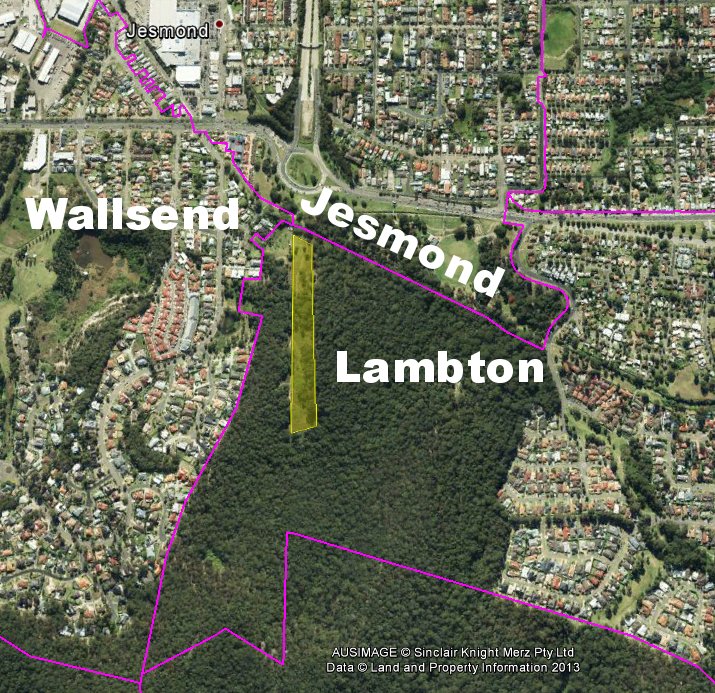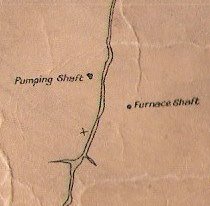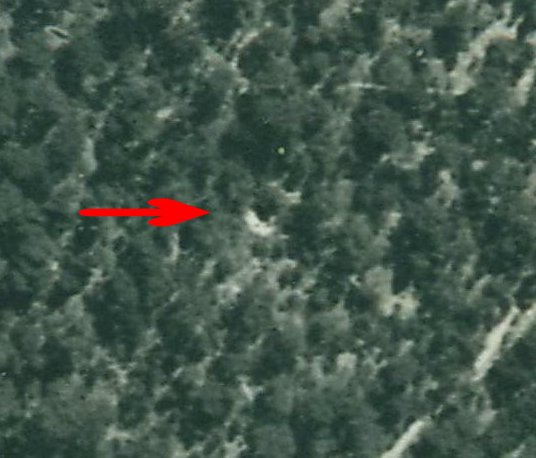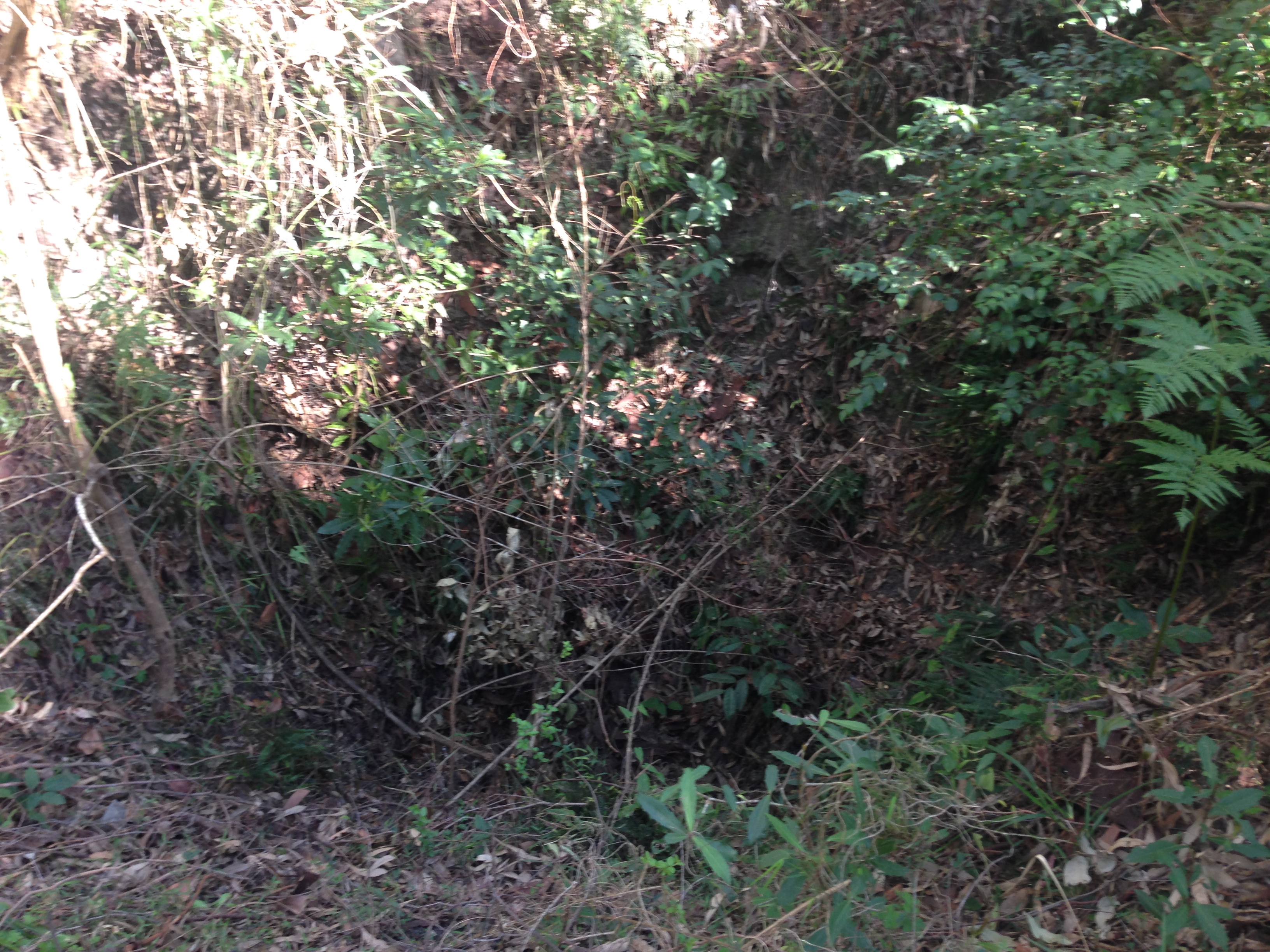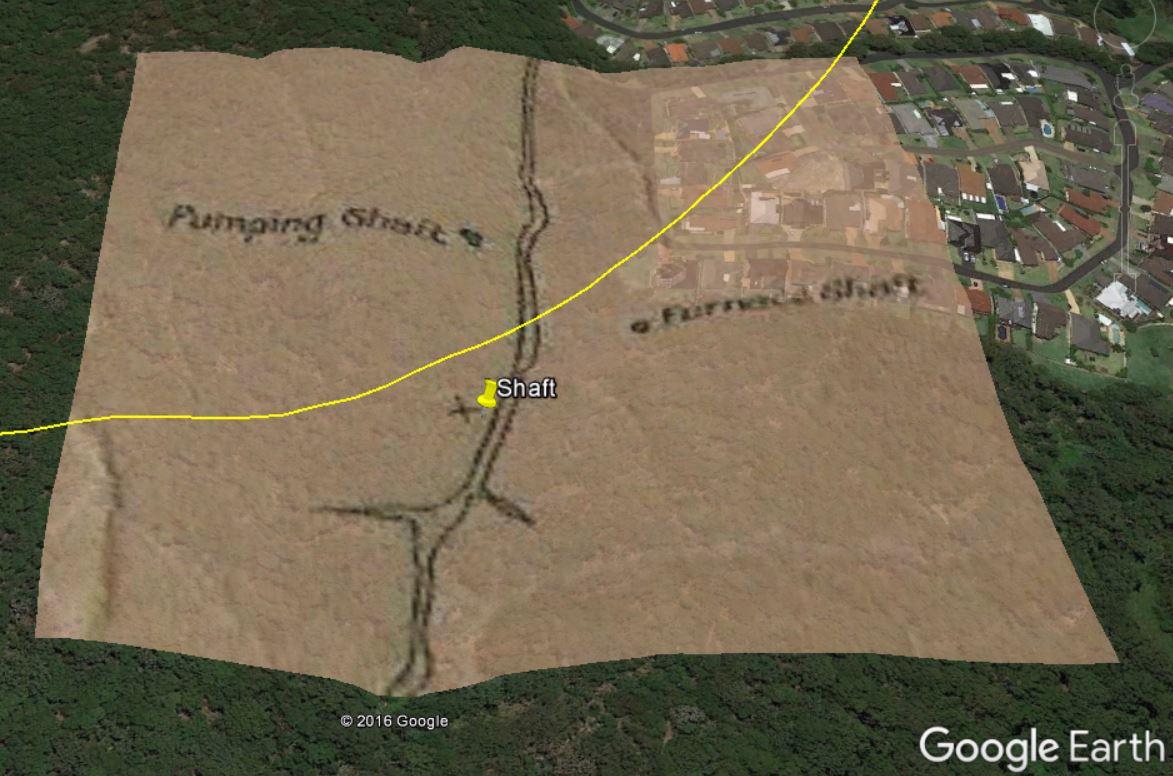The Great Depression of the 1930s saw the rise of many shanty towns across Australia, where unemployed men and their families eked out a makeshift existence. Lambton had such a camp at the boundary with Wallsend near Jesmond Park. Called “Hollywood”, a sarcastic reference to its far from glamorous state, it was also known by the unflattering name of “Doggyville”.
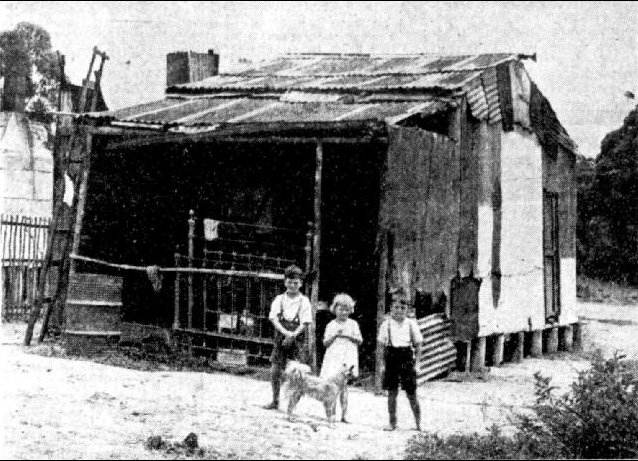
Up to 40 families lived there in huts of varying quality. For example, a family of six lived in the home pictured above. The Newcastle Sun reported in 1941
“They had moved into their home of two rooms, of bags and galvanised iron, when the eldest boy, now nine years old, was a tiny baby.”
A combination of idleness and poverty meant that there was an unsavoury side to the settlement. A regular at the illegal two-up ring in the bush nearby was former boxing champion turned loan shark, John “Slack” Maher, who in July 1951 was shot dead and his body thrown down a disused mine shaft. His brother Michael was soon arrested and tried for the murder, but acquitted by the jury in the face of conflicting and uncertain evidence from witnesses.
Despite these dark moments, many children were raised in “Hollywood” and considered their upbringing as normal, and have fond memories of the fun they had there. The camp persisted long after the Great Depression had ended and was variously tolerated, ignored, or despised. Eventually concern over the living conditions, and the arrival of new social housing alternatives resulted in the eviction of residents in 1958 and demolition of the settlement in 1959.
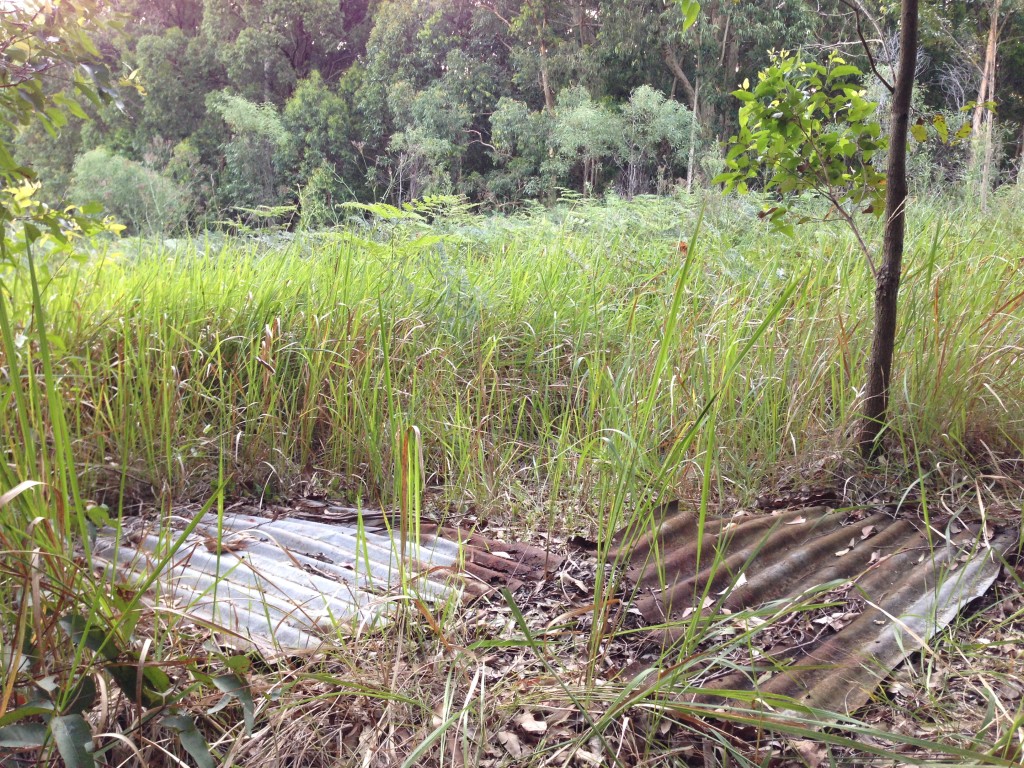
A few rusted and broken fragments of dwellings remain in the bush today, but when the final stage of the Inner City Bypass is constructed (starting in 2017) the site of “Hollywood” will be erased. It will remain only in a few photographs, newspaper stories, and the memories of those who once named “Hollywood” as their home.
The article above was first published in the March 2016 edition of the Lambton Local.
More photos
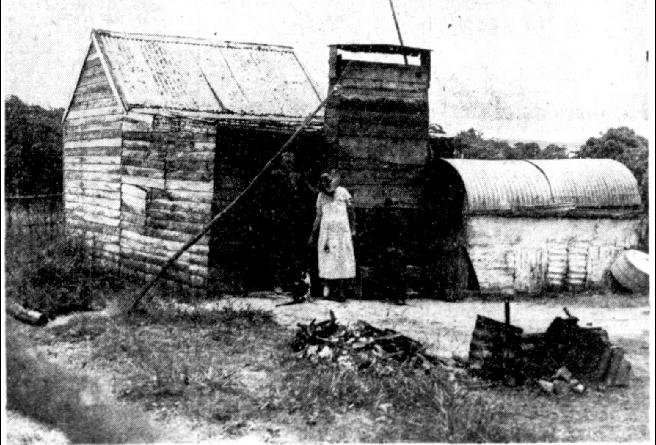
![Portion of an aerial photograph from 1944 that shows the "Hollywood" settlement. Newcastle Library, Local Studies. [Run 5, Image 01465]](https://lachlanwetherall.com/wp-content/uploads/2016/02/Hollywood1944-614x1024.jpg)
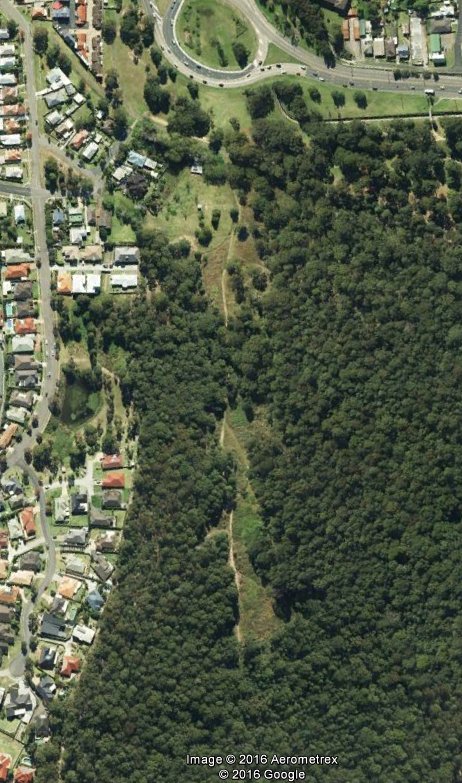
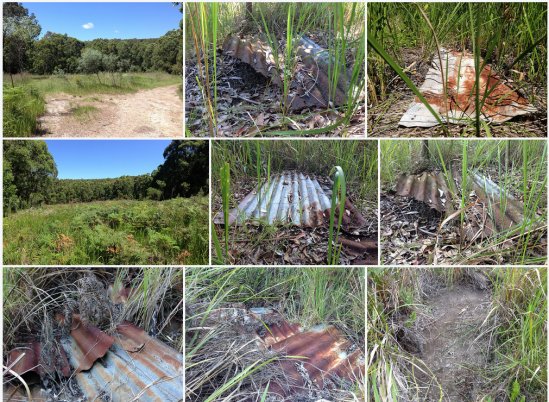
The shiny side of “Hollywood”
Although “Hollywood” was born out of poverty, and undoubtedly had dark and miserable aspects to it, I mention in the article that some who grew up there have fond memories of it. This observation comes from a 2008 article in the Newcastle Herald on Hollywood, where it is said of Norm Surman (who lived in Hollywood up to the age of 15):
“And of the many places Norm has lived in his eventful 68 years, the one he remembers with the greatest happiness is Hollywood.”
Newspaper articles
Trove only stores newspapers for the Newcastle Herald up to 1954. The Newcastle Library however has an online index of headlines from the the Newcastle Herald for the years 1944 to 1984. The headlines listed below give some sense of the the progress and eventual closure of Hollywood over the years 1956 to 1960.
| 28/11/1956 | Action stayed on ‘Hollywood’ |
| 29/1/1957 | Inspection plan on Hollywood |
| 6/2/1957 | Action aim on Hollywood |
| 13/2/1957 | Enquiry wanted on Hollywood children |
| 13/3/1957 | ‘Eye on’ settlement sought – Hollywood Estate |
| 12/6/1957 | Hollywood offer referred |
| 5/4/1958 | No Hollywood evictions by Department |
| 16/4/1958 | Poser on Hollywood occupancy |
| 4/8/1958 | Notices to quit for Hollywood |
| 5/12/1958 | Clearing of Hollywood |
| 11/12/1958 | Eviction action at Hollywood |
| 22/7/1959 | Demolition move at Hollywood |
| 11/12/1959 | New action sought on Hollywood |
| 18/1/1960 | Prosecutions on Hollywood |
| 17/2/1960 | Closures sought – (Hollywood – Jesmond) |
In which suburb was “Hollywood” located?
Many of the newspaper articles refer to “Hollywood” as being in or near Jesmond. The site is adjacent to the conjunction of Wallsend, Jesmond, and Lambton, but is actually wholly contained within the Lambton suburban boundary. The image below shows the modern suburb boundaries in purple, and the site of “Hollywood” shaded in yellow.
The map portion below has the area of Lambton Municipal Council as it was in the 1920s shaded in a dark pink colour, and shows that even then the area where Hollywood would develop was in the suburb of Lambton.
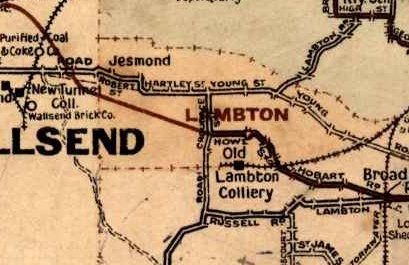
On the map below (obtained from the NSW Historical Lands Record Viewer) someone has marked in pencil on the Lambton/Wallsend boundary “Hollywood Illegal Occupancies Road”.

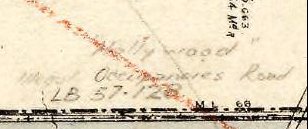 How many people lived in “Hollywood” at any one time?
How many people lived in “Hollywood” at any one time?
In the article I say that “up to 40 families” lived in “Hollywood”. But this is just an educated guess. The only numbers that I have seen recorded are in a newspaper article from 19 April 1945 that states that there were “27 dwellings in the area”, and a report from 7 December 1949 where an alderman said that “between 70 and 80 families lived in the area.”
In the 1944 aerial photograph I can count about 25 dwellings and this corroborates the count reported in 1945. (It is somewhat difficult to distinguish whether some of the smaller structures are separate family dwellings, or just an additional shed or outhouse.)
I am somewhat skeptical of the 1949 report of 70 to 80 families. If true, this implies that the number of dwellings more than doubled in the space of just four years, and this in a time when the depression was long gone, and the post world war recovery was in swing. I suspect that it was more likely to be 70 to 80 people, rather than families.
It seems probable that the population of “Hollywood” in the pre-war, depression era would have been greater than the 27 dwellings of 1945, and given the size of the area that seems to have been used I have made a guess of “up to 40 families” – but it’s only a guess.
The murder of John “Slack” Maher
Dan Proudman and Stephen Ryan wrote an excellent article on the murder, that appeared in the Newcastle Herald on 17 October 2014, so I won’t add anything here except to ask: Where was the shaft that “Slack” Maher’s body was thrown down?
We know from the newspaper reports at the time that:
- it was three-quarters of a mile from Hollywood
- it was a “disused mine vent”
- the shaft was 30 feet deep
- the shaft was near “a lagoon 20 yards away“.
The distance of “three-quarters of a mile” is probably by foot, rather than as the crow flies, so allowing for some meandering of the track I estimate that the direct distance to the shaft would probably be closer to half a mile. The image below from Google Earth shows radius rings at three-quarters of a mile, and at half a mile.
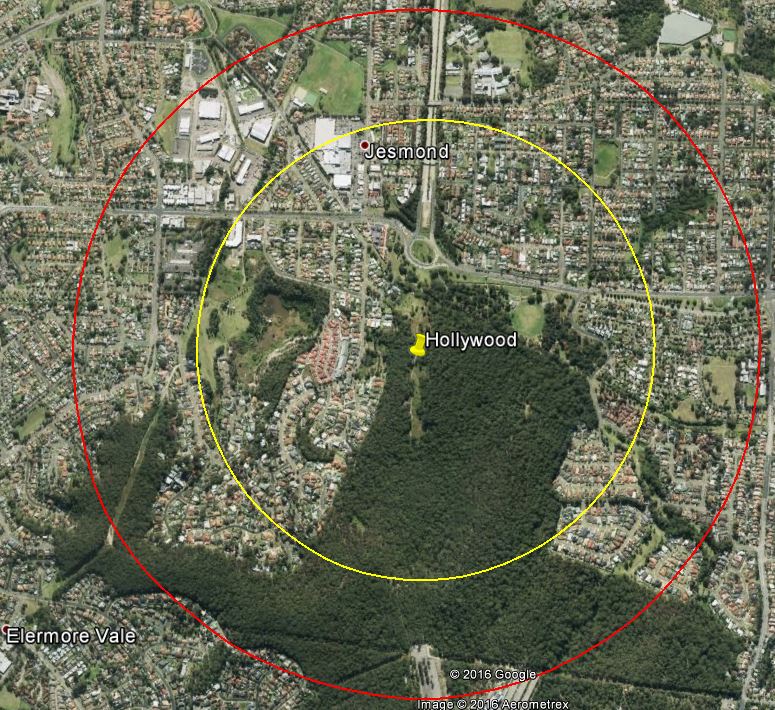
The only map I have seen that has a ventilation shaft marked in this area, is one that has a “furnace shaft” of the Lambton Colliery, furnaces of course being the principal method of mine ventilation in the era before electric fans. This shaft is quite close to a waterway, where trapped water could be described as a ‘lagoon’.
Overlaying this map onto Google Earth shows that the “furnace shaft” is just over half a mile (direct) from Hollywood, which again matches the data.
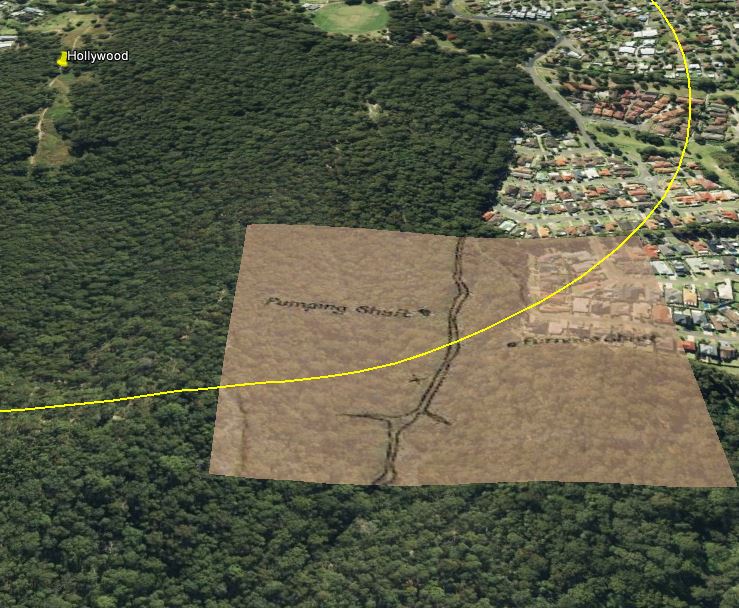
Checking this location in the 1944 aerial photo indeed shows a shaft at this position!
Google Earth tells me that the altitude at this point is 48m. The coal seam that the Lambton Colliery worked outcropped at the surface at an altitude of about 30m, so the ventilation shaft would have been originally 18m deep, which is 60 feet. In 1951 the colliery had been closed for 15 years, so it is possible that erosion had filled in half the shaft, making it only 30 feet deep. Indeed the crater-like appearance of the shaft in the 1944 photo suggests that a significant amount of cave in of material had already occurred.
So was this the shaft that the body of “Slack” Maher was thrown down? I don’t know, and there’s no way of knowing for certain. All I know is that this shaft is consistent with the evidence I have seen.
Update
While wandering through the bush in August 2016,near the shaft location identified above, and looking for something completely unrelated, I came across the remains of another mining shaft that I previously had no knowledge of.
This shaft is actually a much better candidate than the “furnace shaft” identified in the previous section. The furnace shaft is about 60 metres from the creek, which didn’t quite tally with the description that the shaft was near “a lagoon 20 yards away“. This new shaft I discovered was quite near a flat area of the creek which could be described as a lagoon. Also being lower down near the creek, tallies better with the reported depth of the shaft. I captured the GPS co-ordinates of the shaft, and when I got home loaded them into Google Earth. Much to my surprise I found that the location matched up almost exactly with an X on the old map that I previously had paid no attention to!
I suspect that this shaft was a downcast (inlet) ventilation shaft, whereas the the furnace shaft which is about 100 metres distant was the upcast (outlet) ventilation. So was this the shaft that the body of “Slack” Maher was thrown down? I don’t know, but it’s a good candidate.
Anecdotes of “Hollywood”
- Recollections of Hollywood by a local, on the Australian Metal Detecting and Relic Hunting web site.
- Danny Williams e-mailed me a recollection from his father about “Hollywood”.
“My old Dad (who was a doctor) used to make calls there to visit patients. On one visit he was apparently beaten up by a drunk – after this he always took a “minder” with him to Hollywood. “
- Robert Watson, in an e-mail said:
“Even in the 1960s, kids in my class would relate tales that if you went into the bush there, the guys playing two–up would catch up and hang you up by your thumbs! Obviously a tale spun by their parents to keep them out of the bush!”
- There was a couple of posts of “Hollywood” on the “Lost Newcastle” Facebook page in February 2015. Here’s a few comments from there:
- “We lived across the road from Jesmond park in Charlton street. As a child I enjoyed many hours of fun walking around Hollywood and going up to the two up ring. We would watch the cars and taxi”s drive up to the old road that ran up the side of the old skyline to drop the men of for their game of two-up on Friday Nights. Next morning we would go up and try and find any pennies .Those were the days.“ – Margaret Russell
- “You could see the tin houses from the tram. My mother said people that were homeless during the depression went there to live but it was there many years after that. It was there all of the war years and after.” – Dorothy Scammell
- “My father helped pull several of the old houses down there . I remember quite well as I assisted as a young boy and remember standing on my first rusty nail. Boy did that hurt.” – Greg Wakeman
- “I remember “Hollywood” and its makeshift housing very well…..used to pass it on my way to work during the 50’s. Both it and Platt’s Estate at Waratah were the only places that were considered to be socially inferior to my hometown of Minmi. I later went to Newcastle University with a person whose childhood had been spent in “Hollywood”……..Not bad for a pair of scrubbers from the other side of the tracks.” – Shirley Hetherington
Links
Newspaper articles
“Hollywood”
| Article Date Event Date | Notes |
|---|---|
| 23 Sep 1929 | Jesmond Progress Association arranges to install a drinking water service at Jesmond Park. This is just a few weeks before the stockmarket crash of October 1929, an event that will lead to a large increase of residents at "Hollywood", who will then use this water supply for drinking. |
| 15 Mar 1936 | "DOGGYVILLE" OR "HOLLYWOOD." Suggestive of extremes, "Doggyville" and "Hollywood" are the alternative names with which a growing unemployed hamlet between Wallsend and Lambton has been "christened." On the Wallsend-Lambton boundary the camp flanks the southern side of the picturesque sec- tion of the Newcastle Wallsend tram route, between Lambton and Jesmond. |
| 21 Dec 1939 20 Dec 1939 | Visit to "Hollywood" by Minister for Works and Local Government, Mr L O Martin. "The Minister and a lot of other people followed a rough track until they reached a collection of shacks in the bush where many people and a seemingly endless number of children live." |
| 24 Jan 1941 | Photos of shanty huts at Hollywood and Platts Estate. |
| 24 Jan 1941 | Description of one family who have been living in Hollywood for the past nine years. |
| 22 Mar 1945 | "Because there were no roads in the area the ambulance and doctors at Wallsend were unable to enter "Hollywood" area, Jesmond, to attend urgent medical cases Ald. King informed Greater Newcastle Council." The council thinks that Hollywood is located on the mining company's property. "The engineer of the old Wallsend Council had stated that the people at "Hollywood" had built on a roadway." |
| 19 Apr 1945 | Council unable to construct roadways at Hollywood. There are 27 dwellings in the area. |
| 17 May 1945 | "Greater Newcastle Council should do all in its power to help people living at Hollywood (near Jesmond) to get into good homes, Ald. Lewis said at the council meeting last night." |
| 18 Dec 1945 | "A woman and three young children lost all their possessions in a fire which razed their home at "Hollywood," near Lambton, during yesterday's heat." |
| 7 Dec 1949 | "Ald. Armstrong said between 70 and 80 families lived in the area … Ald. Rundle said the houses were built on Crown land and the tenants had to pay neither rates nor rent." |
| 28 Feb 1950 | "The formation of a road to "Hollywood" "squatters'" settlement, near Jesmond, where 70 to 80 families were housed on private land, was not a council responsibility, Newcastle Council Works Committee decided yesterday after an inspection." |
| 10 Apr 1954 | "Mr. Meddows said home building was fast encroaching the sub-standard settlements of Platts Estate, Waratah West, and Hollywood Reserve, Jesmond. Early this year a complete social survey had been made of Platts Estate with the object of reorienting housing facilities for the people living in sub-standard structures." |
| 17 Oct 2014 | "One down at two-up" - article in the Newcastle Morning Herald by Dan Proudman and Stephen Ryan, on the murder of 'Slack' Maher. |
The Murder of “Slack” Maher
| Article Date Event Date | Notes |
|---|---|
| 14 Jul 1951 | "Police so far have found few clues to the identity of the killer who shot 48-year-old ex-boxer and pensioner John ('Slack') Maher near his home in the crude shanty town of Hollywood at Jesmond last Wednesday afternoon. After 48 hours' search, police and civilians yesterday followed a three-quarter-mile blood trail along a muddy, bush fringed track to an old, disused mine vent, where the battered body of Maher was found with a bullet through the back of his head … His connection with a two up school at Jesmond was his 'work.' He made a business of lending money to players who went broke and kept the names of his 'clients' in a little black book." |
| 14 Jul 1951 | "Police recovered the body of John Maher, 41, pensioner, from the bottom of a disused mine shaft at Jesmond yesterday afternoon. There was a bullet wound in the back of the head. Police believe that Maher was shot a quarter of a mile from his home, carried three-quarters of a mile through the bush and thrown down the shaft." |
| 16 Jul 1951 | "Detectives and other police made extensive inquiries at the week-end into the murder of John Maher, 44, of Hollywood settlement, near Jesmond, last Wednesday. Detectives interviewed a large number of people and took statements from a number of Maher's former associates." |
| 20 Jul 1951 | "Newcastle and Sydney detectives, directed by Detective-Inspector J. Ramus, widened the scope of inquir ies yesterday into the murder of John ("Slack") Maher. Outer suburbs of Newcastle were visited and known associates of the murdered man were questioned." |
| 21 Jul 1951 | "Cook's Hill Fire Brigade yesterday pumped an estimated 50,000 gallons of water from a dam at Jesmond at the request of detectives investigating the murder of John Maher. Police found nothing in the dam that would help them in their in quiries." |
| 25 Jul 1951 | "Michael Joseph Maher, 50-year-old laborer, was remanded until Aug. 8 when he appeared in Newcastle Court this morning on a charge of having murdered his brother." |
| 9 Aug 1951 | Inquest into the death of Ernest John ("Slack") Maher, 48, pensioner and ex-boxer, of "Hollywood," Jesmond. |
| 9 Aug 1951 | "There was a dramatic turn in the Jesmond mine-shaft murder inquest to day when a witness alleged, 'I saw Mick Maher put a .22 rifle to his shoulder." |
| 10 Aug 1951 | "Two shots were heard after Michael Maher had put a rifle to his shoulder following argument with his brother at Jesmond, a witness said in Newcastle yesterday." |
| 13 Aug 1951 | "A witness at the Jesmond mineshaft murder inquest today said he saw Michael Joseph Maher leave the Hollywood settlement in a truck about 2.30 p.m. on July 11 and did not see him again until he returned about 4 p.m. The witness, John Gilbert Buxton, admitted that this differed from a statement he had previously given to the police, because he had had 'time to think it over.' " |
| 14 Aug 1951 | "Michael Joseph Maher, 50, laborer, was today committed for trial by the Newcastle Coroner (Mr. T. H. D. See) on a charge of having murdered his brother at Jesmond on July 11." |
| 19 Nov 1951 | Maher Murder Trial Begins. Michael Joseph Maher (50), laborer, pleaded not guilty to a charge of having murdered his brother, Ernest ('Slack') Maher on July 11." |
| 21 Nov 1951 | " 'I had no hand or part in the death of my brother,' Michael Joseph Maher, 50, laborer, declared today at the Central Criminal Court where he had been charged with having murdered Ernest John ('Slack') Maher, 48, pensioner, at Jesmond on July 11." |
| 22 Nov 1951 | "Michael Joseph Maher (50), laborer, charged with having murdered his brother at Jesmond on July 13, today called witnesses to support an alibi defence." |
| 23 Nov 1951 | "Michael Joseph Maher was the first person to tell the police about the mineshaft in which the body of his brother, 'Slack' Maher, was subsequently found, a witness told the jury today at the Maher murder trial in the Central Criminal Court." |
| 24 Nov 1951 23 Nov 1951 | "Two witnesses whose evidence was said to be material to the Crown failed to appear when called yesterday at the trial of Michael Joseph Maher." |
| 25 Nov 1951 24 Nov 1951 | "A Central Criminal Court jury yesterday acquitted Michael Joseph Maher, 51, of a charge of having murdered his brother, Ernest John Maher." |
| 26 Nov 1951 24 Nov 1951 | "Michael Joseph Maher (50), laborer of Victory-pde., Wallsend, was found not guilty of having murdered his brother." |
Admin note
Some of the comments below were originally posted to the “Paddy Lewis” article. I have moved them here, as this page is now a more relevant context for the comments.

